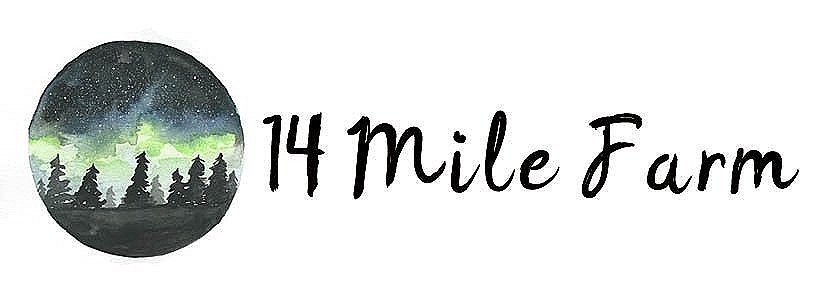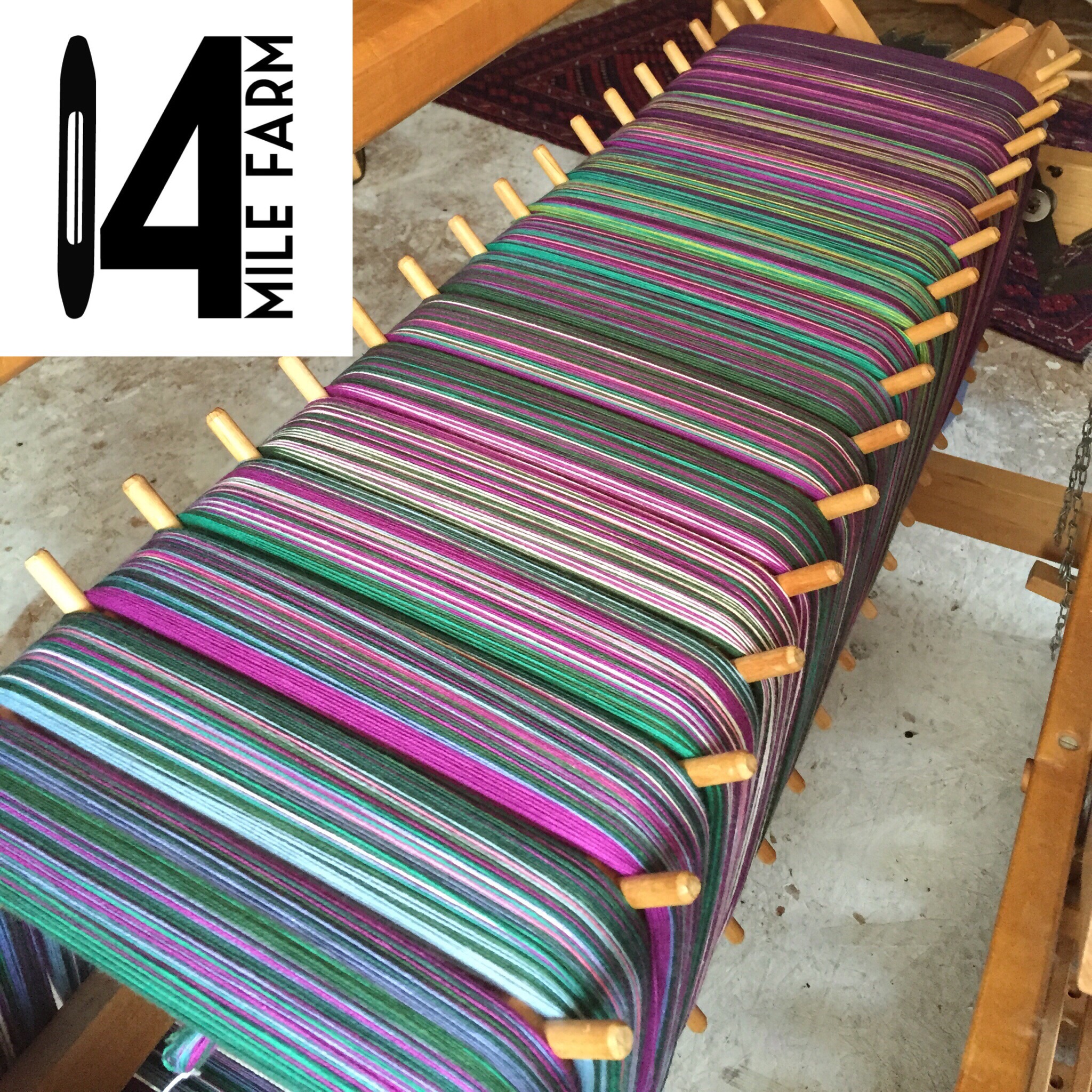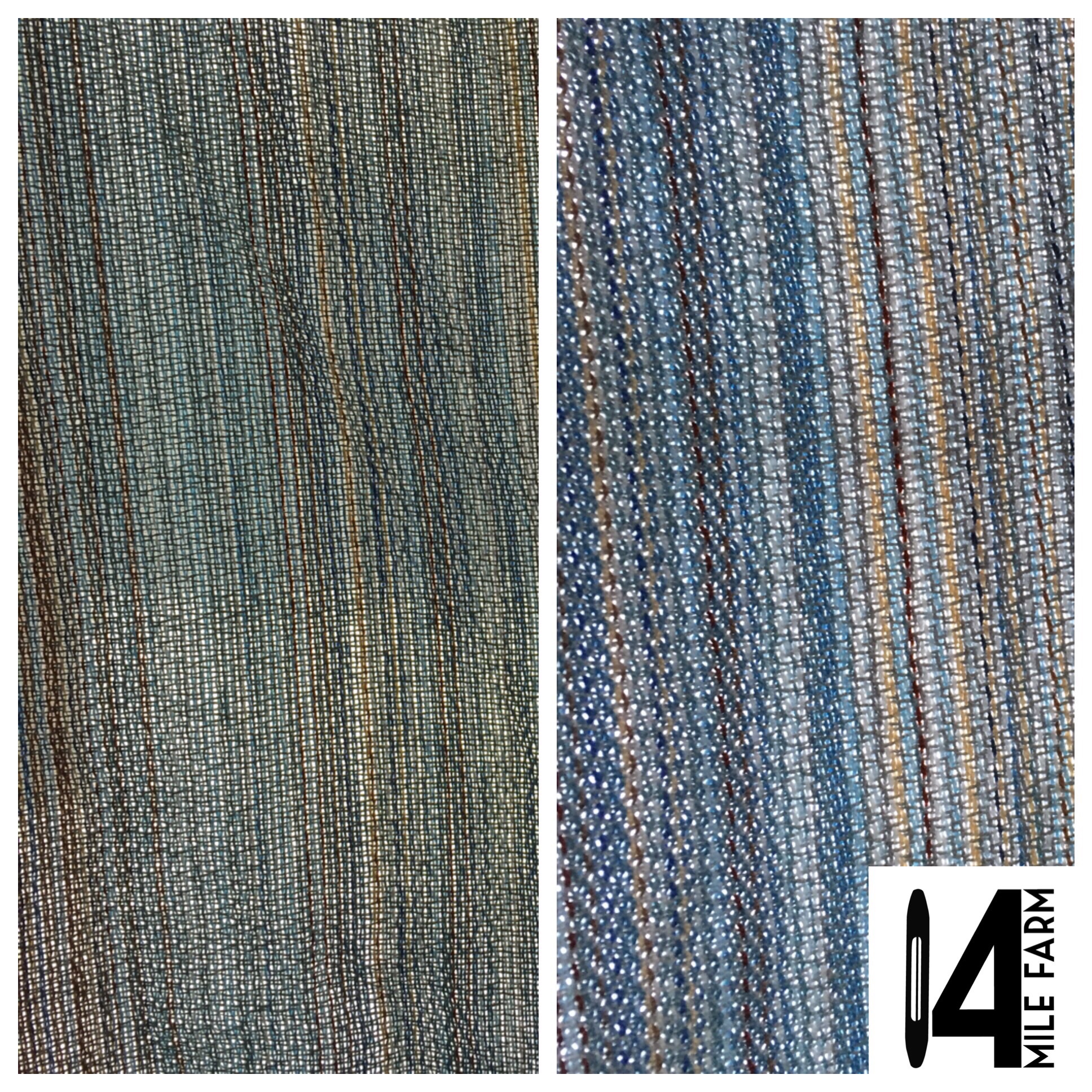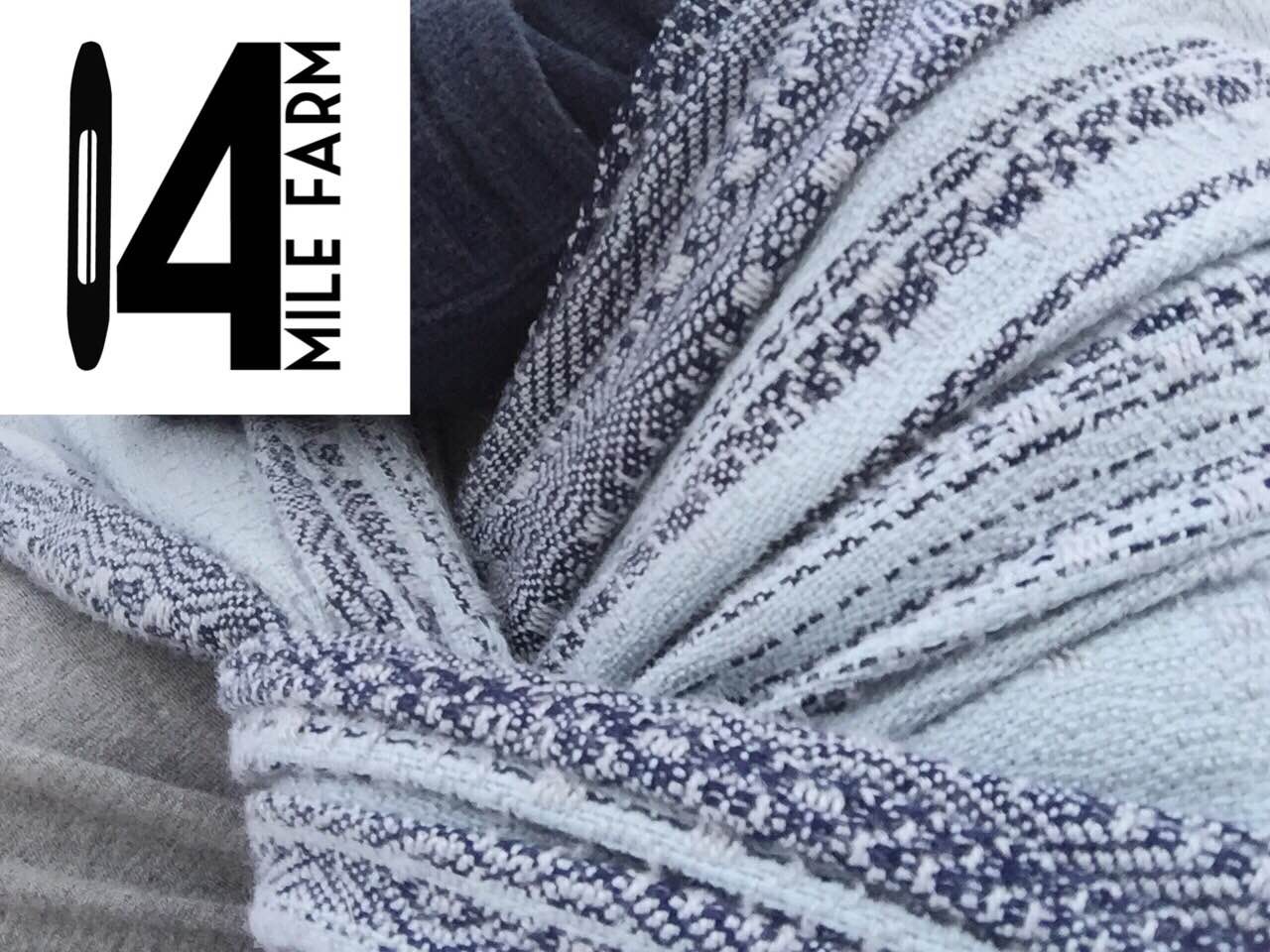Welcome! Please feel free to subscribe to the newsletter to get studio updates and projects from the archives straight to your inbox.
Field of Dreams
Field of Dreams is the most recent warp to come off of the loom here at 14 Mile Farm. Its woven in a "crackle" weave by Ralf Griswold. The warp is 8/2 cotton from Maurice Brassard.
This wrap was inspired by the fireweed that blooms in the Alaskan summer.
Fireweed covers the landscape here in interior Alaska in the summers. It is a very resilient plant, the first to return to area after a forest fire, hence the name. Each flower on the stalk fluffs out like a dandelion in late summer and is blown on the wind to reseed the land for the next year.
It grows on roadsides, in meadows and fields, and covers the hill in our front yard.
The warp moves through spring to summer greens, with magenta and fuschia followed by the grey blues of a late summer sky, and natty pinstriping to evoke the the fluff of the fireweed going to seed.
Here we see the cloth building up on the cloth beam. It is one of my favorite and most satisfying sights as a weaver. You can see the weft change from the magenta to the greens.
This piece is woven with a magenta Tencel, and will be staying here with us. The combination of the grippiness of the crackle weave with the glide provided by the tencel makes for divine wrapping qualities.
A cowl in grey Tencel. Tencel in a crackle weave is one of my new favorite things. I love the play between the shine of the tencel and the matte unmercerized cotton. So soft!
This piece was woven with a hand-dyed variegated Tencel weft in shades of green and will be flying to a new home.
I love the way that the variegated greens are evocative of the oh-so-green summer landscape that fireweed blooms against. This weft came together even better than I had hoped.
Bands of magenta tencel in the tails of the variegated piece to highlight the bright color of the flowering fireweed.
The variegated weft was a joy to weave, always changing. I see more hand-dyed yarns in the future here at 14 Mile Farm!
What is wet finishing?
Many machine-woven baby wraps are delivered to the customer in loom state and the buyer must do their own initial wet-finishing. Most handwoven baby wraps, and all 14 Mile Farm handwoven babywearing wraps, are delivered to the customer post wet finishing and ready to wear.
Wet finishing is the final step in making a piece of cloth on a hand loom. It is easy to think that the fabric is complete when it rolls off of the cloth storage of the loom, but that is not the case. Handwoven fabric in “loom state” is not yet finished. Wet finishing is the process of washing and drying the woven cloth for the first time.
Bloom shot!
Weaving yarn is (for the most part) spun in industrial mills. The equipment that spins the yarn is lubricated with oil, and this spinning oil ends up lightly coating the spun yarn. The wet finishing process removes this oil, allowing the yarn to ‘bloom.’ As the fabric goes through the process of being washed and dried, the individual fibers in the yarn are able to fluff, shrink, and/or settle into their preferred state.
You can see the way the texture of the fabric changes, and the drape comes into being post-wet finish.
Measurements pre- and post- wet finishing can vary by 10-15% or more. Every yarn and every fiber combination will have different rates of shrinkage. In the case of wool wet finishing must be done carefully, allowing the wool to full (bloom) but not to felt. In general wool should washed in cold water with minimal agitation. Always follow your care instructions!
I was surprised by just how much the color of the warp was revealed post wet finishing. You can see the herringbone weave structure more clearly in the second photo as well. Both photos were taken in front of a window in very similar light. This change is due in part to the way that the wet finishing process lets the weft (grey here) really move three dimensionally going over and under the warp threads as it looses the two dimensionality imposed by tension on the loom.
Many machine-woven baby wraps are delivered to the customer in loom state and the buyer must do their own initial wet-finishing. Most handwoven baby wraps, and all 14 Mile Farm handwoven babywearing wraps, are delivered to the customer post wet finishing and ready to wear.
Spark
Spark is a hadwoven babywearing wrap entered into the Spring 2016 Great Competition of Weavers.
In my head, Spark is one classy lady. She shines in pearls and high heels, elegant and poised. She loves a classic ensemble of blue jeans, a white t-shirt, sunglasses, and flats. She’s the kind of woman you admire from afar, wondering how on earth she manages to be all that she is and when you get to know her you are blown away by her kindness, her caring, and her warm hugs.
The Spring 2016 Great Competition of Weavers theme was “Under the Microscope.” This competition was only open to OOAK (one of a kind) wraps, so this is the only piece of Spark there ever was or ever will be. Spark is inspired by the process of mitosis.
As the daughter of a biologist, I have many fond memories of peering into the magical microscopic world contained in a drop of pond water. I was fascinated by “zoomers,” my childhood name for microbes that shot across the slide propelled by cilia or flagella or amoeboid movement. Yeast was particularly cool to watch, because of how FAST they multiplied! Dad was a PhD student in the early ‘90s and did much of his dissertation work on an electron microscope. It lived in its own room down the yellow linoleum hallway and I remember being SO impressed by it and by what could be seen through it. I was 5 years old. I remember the sheer magic of catching a “zoomer” when it was splitting in two, and it was this memory that I hoped to capture with “Spark.”
I considered a black/white/grey grad in homage to the images that we see through electron microscopes, but at least in my memory, the early behemoth of a microscope I stood on a stool to peer into gave a blue cast to its images, and I chose to show this in “Spark.”
Spark is woven in an overshot variation where the warp intersects with the tabby weft to make a ground of plainweave. In this particular variation there are actually a few picks of basketweave (basically a doubled thread plainweave) in this ground cloth. The pattern weft then floats over this ground to create the pattern. The ground of plainweave means that this is a very strong cloth even though the pattern weft has floats that are longer than would otherwise be optimal for the purposes of a baby wrap.
Funny story: when I first went to look at Maggie (my loom), her former owner – a weaver in her 80’s who had to retire from weaving due to degenerative arthritis in her hands - asked me what I was most excited to weave. I had just learned overshot in my weaving class and had fallen hardcore in love with the weave. I told her that I was most excited to weave overshot. Fast forward 8 or 9 years and this is the first full project that I’ve woven on it in overshot. There are always oh so many tempting projects!
I truly love this structure, and it is super fun and fascinating to see it come to life behind the passing of the shuttles but it is not a quick weave. After each pick, the weaver sets down one shuttle, picks up the other and throws it, making sure that the two wefts stay cleanly wound around each other along the selvedge. I set up my treadles so that my right foot was treadling the plainweave tabby picks, and my left foot was treadling the pattern picks. Each single pattern repeat required 74 steps on the treadles. I believe that I picked up speed the last meter or so, but I was averaging 10 inches per hour. And that’s based on an hour of strict weaving, no pauses to check my phone or nurse a baby or repair a broken thread!
I also love that the process of mitosis – the division and replication of one into two – speaks to this precious era of babywearing. This blink of time when our children are so very little is when they learn to identify themselves as themselves. Early childhood development experts talk about the process of individuation, that babies begin life with a recognition of mom as part of self and have to learn that they are actually two beings. Babywearing allows us to continue holding them as they undergo this transition into independence. The 4th trimester and the concept of the motherbaby dyad are biological and psychological realities that I wish were better understood and recognized by our culture.
Spark’s final measurements are 3.2 m stih weighing in at 280 gsm.She is woven with 16/2 cotton for the warp and tabby weft and 8/2 lyocelle (commonly known as Tencel) pattern weft.
If you are interested in following along more closely as things go onto and come off of my loom, please come join my Facebook group! I also post updates on Instagram.












































